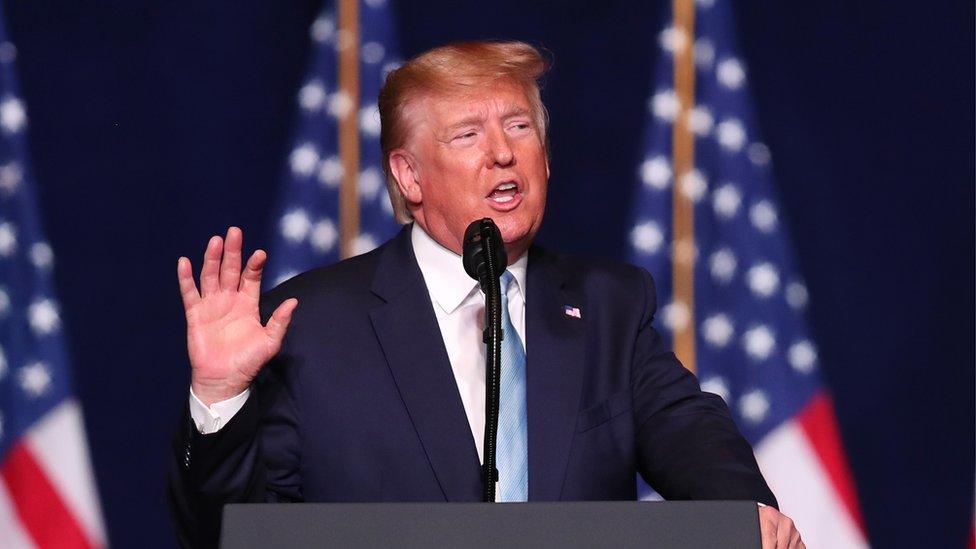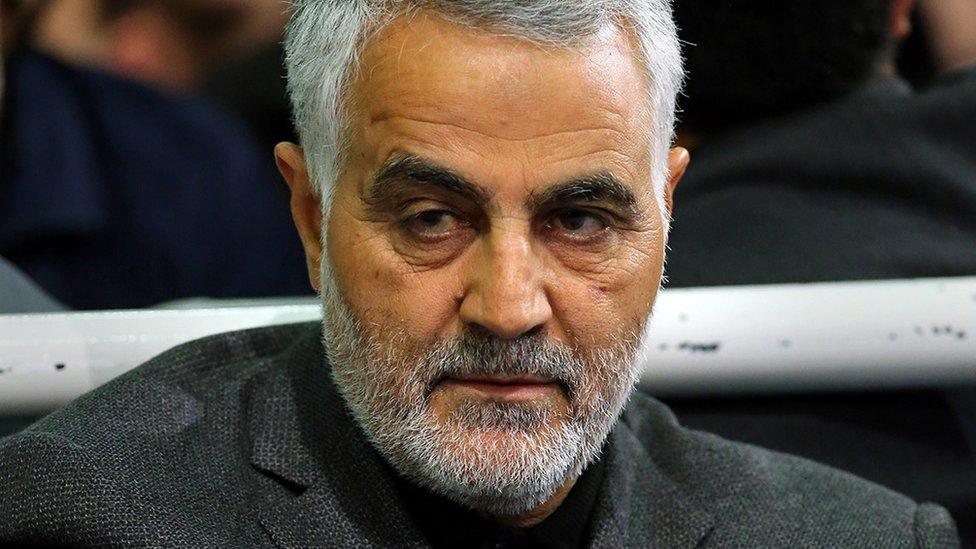Qasem Soleimani: Stampede kills 50 mourners at burial in Iran
- Published
Huge crowds took to the streets in Soleimani's hometown
Fifty people have been killed and more than 200 injured in a stampede as Iranians gathered for the burial of a leading commander killed in a US drone strike.
The deaths in Qasem Soleimani's hometown of Kerman led to the ceremony being delayed.
The burial is the last in a series of funeral events that have brought millions on to the streets in Iran.
Soleimani's killing has raised fears of a conflict between the US and Iran.
The head of the Quds force was tasked with defending and projecting Iranian interests abroad, and was hailed as a hero by many in his home country. Immediately after his death, Iran threatened retaliation.
To the US, Soleimani was a terrorist, and in explaining why he ordered the strike, President Donald Trump said he was acting on an "imminent" threat.
What happened in Kerman?
The crush in the south-eastern Iranian city happened at the start of a funeral procession that had drawn vast numbers of people on Tuesday morning, ahead of the planned burial.
Eyewitnesses told BBC Persian the streets were not wide enough to hold the number of people and, with other roads closed off, there was nowhere to escape to.
A coroner quoted on Iran's Isna news agency put the death toll at 50, with those injured numbering more than 200.
Video online showed people on the ground, their faces covered by clothing.
Who was Qasem Soleimani?
Iranian media later reported that the burial had resumed. Video footage showed the procession of Soleimani's casket. People threw items of clothing which officials touched against the casket before returning them.
Top Iranian officials renewed their threats of revenge. "The martyr Qasem Soleimani is more powerful... now that he is dead," the Revolutionary Guards' top general, Maj Gen Hossein Salami, told crowds in Kerman.
The Guards were set up to defend Iran's Islamic system and are a major political and military force. The Quds Force is its overseas operations arm.
Mourners in Kerman chanted "death to America" and "death to Trump", reporters there said.
In other developments:
In Iraq, thousands took to the streets in the southern city of Basra for the funeral procession of Abu Mahdi al-Muhandis, head of the Kataib Hezbollah militia group who was killed alongside Soleimani. Muhandis was the Iranian's top adviser and ally in Iraq, and a powerful leader among Iraq's Shia militias
The US reportedly denied a visa for Iran's Foreign Minister Javad Zarif to visit the UN in New York this week, a move that appears to breach an agreement guaranteeing foreign officials access to UN headquarters
The US has denied it is pulling out of Iraq, after a letter from a US general suggested there would be a withdrawal
Iranian parliamentarians have approved a motion designating the US Army and the Pentagon as terrorist organisations, and allocated extra funds for the force once headed by Soleimani

A show of unity?
Analysis by Kasra Naji, BBC Persian
Only seven weeks ago, Iran witnessed the biggest and most violent anti-government demonstrations in decades. Security forces killed anywhere between 330 and 1,500 protesters in more than 100 cities across the country. Thousands more were injured and arrested.
So why have so many people come out to pay homage to Soleimani, in spite of widespread discontent?
There is no doubt that feelings are running high. Arguably the most important man in the country's armed forces has been assassinated by the US, which for many is the arch-enemy of Iran.
But it is also clear that the government launched a massive effort to mobilise as many people as possible. A huge turnout sends a strong signal to Donald Trump that the government enjoys widespread support.
It sends the message that a war with Iran would rally Iranians behind their leaders in the event of foreign aggression, and that any war could well be long and costly.

What are the latest US-Iran exchanges?
In an interview, Foreign Minister Zarif called Soleimani's killing an "act of war" and said Iran's response would be against "legitimate targets".
Iran's foreign minister says the US has not pursued de-escalation since killing Soleimani
Mr Zarif said President Trump had been "misled" by Secretary of State Mike Pompeo.
"[Pompeo] believes people were dancing in the streets of Tehran and Baghdad... Now I think that he has seen the sea of humanity in Iraq and Iran yesterday. Doesn't he want to admit that he's been misdirecting American foreign policy?" Mr Zarif asked.
On Tuesday, Mr Pompeo said at a briefing that if Iran made another "bad choice", President Trump would act in a "decisive, serious manner".
Pompeo mocks the idea that Soleimani was on diplomatic mission
He was also questioned about Mr Trump's controversial threat to target Iranian cultural sites.
Mr Pompeo denied he and other top officials had contradicted Mr Trump on the issue and said it was Iran's leaders who had damaged Persian culture.
But he again said US military action would be within international law.
Mr Pompeo also referred to media reports that Soleimani had been on a peace mission to Baghdad at the time he was killed, saying: "We know that wasn't true."
- Published6 January 2020

- Published9 January 2020

- Published3 January 2020

- Published3 January 2020
